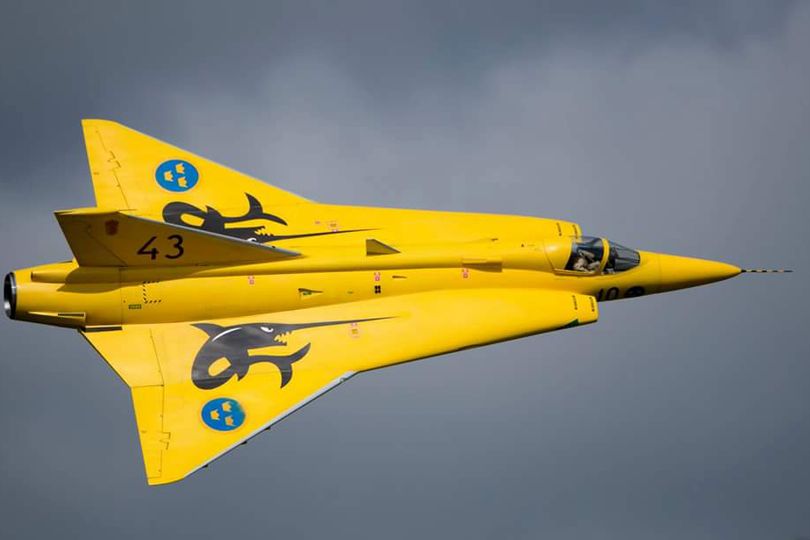When automotive enthusiasts hear the name Saab, they probably always think about the famous car manufacturer. The manufacturer that we now miss greatly, but that also produced some utterly amazing cars. Think of the 9-3 Viggen perhaps, or the utterly insane looking Sonett III. But something that is easily forgotten is that the Saab name is still going strong. Except it’s not in the world of cars. Oh no! The Saab name is going strong in the world of military aviation, and has done since the late 1930s.
Saab’s latest aircraft is the JAS 39 Gripen and it is one of the most capable multirole fighter aircraft in the world right now. And it follows a long tradition of Saab producing utterly incredible aircraft. One of the very best has to be the Saab 35 Draken. This fearsome, delta wing aircraft is an all-time classic and remarkably to this day, there are examples of the Draken still flying in private hands and in the hands of the Swedish Air Force Historic Flight.
Development Of The Draken

The desire for the Draken was born out of Sweden foreseeing that they would need a jet fighter that could both intercept bombers at high altitude, and engage with enemy fighters. This can be traced right back to the start of the jet age in 1949, and the new aircraft would have to be an all-weather fighter to be flown by a single pilot. The aircraft would also have to be suitable to operate on rough, public roads, and the Saab company soon found out that a lot of the issues posed by the design could be met with a delta wing aircraft. Delta wings at the time were a novelty, but Britain showed they could be successful with its Avro Vulcan bomber.

Like with the Vulcan, Saab built a smaller, research aircraft dubbed the 210, and it earned the nickname “Lilldraken” which translated to little kite. Tests with the Lilldraken proved the concept would work, and the first flight of a Draken prototype took place on October 25th 1955. In 1956, the first operational version of the Draken, designated the J 35A, was ordered into production. The impressive new aircraft reached Mach 2 for the first time on January 14th 1960, thanks to its modified British made Rolls-Royce Avon Mk.48A engine. Sweden had just developed a brilliant new delta wing aircraft.
The Draken In Service

The Draken would soon enter Swedish Air Force service, with deliveries of the J 35A taking place at the end of 1959. By the end of the following year, multiple wings in the air force were now equipped with the Draken. Exercises in 1959 had shown that the scramble and turn-around times of the aircraft were good, and the introduction into service of the aircraft had gone quite smoothly. Its good quick-turn ability and hight speed at all altitudes accidentally meant the Draken would be good as a fighter plane as well as an interceptor.

Over the years, the aircraft would receive plenty of upgrades. There were six different versions of the aircraft, the final model of which was the J 35F, the last version to remain in Swedish Air Force service. Exports of the aircraft also took place, most notably to Denmark and Finland, while Austria bought 24 Draken Ds in 1985. The aircraft thankfully never saw combat service, but the type no doubt would have proven successful had it done so. Eventually, the Draken would be replaced by its successor from Saab, the Viggen.
A Happy Retirement For The Draken

Following its retirement from service in Sweden at the end of 1999, Drakens would go on to fly for a mew more years in Austria and Denmark, before the final retirement of the type in Austria in 2005. The Draken had become a hugely popular and iconic aircraft in the aviation world thanks to its delta wing design. And as such, a large number of the type are on display around the world. There are also two airworthy with the Swedish Air Force Historic Flight, as well as a pair of Dakens flying out of McClellan Air Park in California in the United States.
The Linage Of The Draken

The Draken would effectively start a run of hugely successful Swedish Air Force jet fighters. The Viggen would be introduced into Swedish service in June 1971, while it would in turn be replaced by the JAS 39 Gripen, an aircraft that is still in service to this day. The Gripen as first introduced into active service in June 1996 and has been exported to a few air arms around the globe including the Czech Air Force and Brazilian Air Force. Despite the loss of the car brand, Saab is still going strong to this very d ay in the aviation world.
